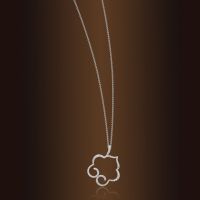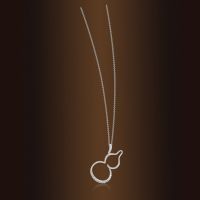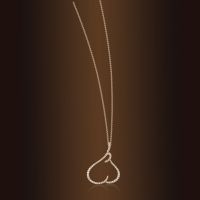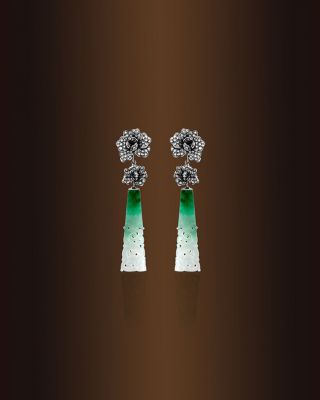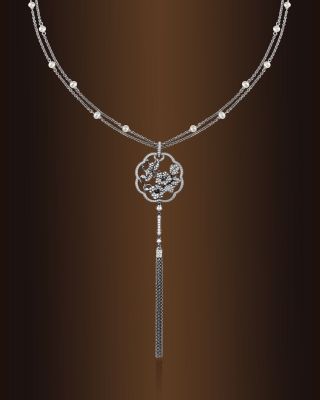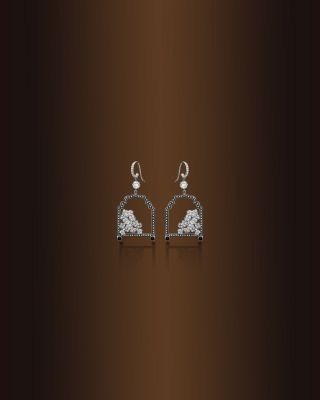AUSPICIOUS
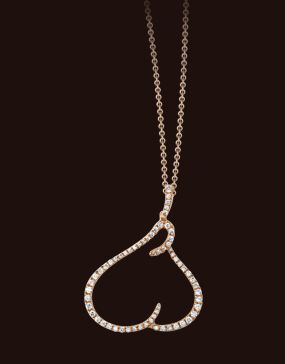
This series is based on 11 common Chinese auspicious symbols, all of which carry different auspicious meanings through their unique styles, artistic connotations and distinctive features. Popular in decorative folk arts for thousands of years, all of them have a special role in traditional Chinese culture, as the emblems are believed to portend luck and good fortunes.
Using diamond micro-setting technique, life of circle has reinterpreted the 11 motifs into a series of exquisite 18k gold and diamond earrings and pendants.
Ancient Coin
The motif of ancient coin can simply represent prosperity and wealth. It also represents the dualism of the universe – the circle form of the boundary refers to the heaven, while the hole in the middle symbolizes the earth. It also means the harmony between female (yin) and the male (yang), therefore, an emblem of Tai chi.
Cloud of good luck
Since the pronunciations of “cloud” and “luck” are very similar in Mandarin, cloud is an emblem of luck in Chinese culture. Cloud is always an important motif in Chinese works of arts and culture as it is the origin of water, one of the key elements of our nature. Also, the representations of God and fairies in many art forms are very often accompanied by clouds.
Buddha’s hand
Buddha’s hand, also called Buddha’s hand citron, is a kind of citron fruit. In Mandarin, the first character of Buddha’s hand, “fu”, meaning Buddha, sounds like ‘luck’ in Mandarin. This makes Buddha’s hand a symbol of luck in Chinese culture.
Peach of longevity
Peach, a fruit originated inChina, is always a symbol of longevity. Steamed buns filled with red bean paste or lotus seed paste in the shape of peach are always served for celebrating one’s birthday.
Gourd
Gourd is used to wish the newly married couple the blessings of many children, since it is a sign of “continual birth” in Chinese tradition. It is believed that the gourd can embody heaven and earth, and to contain spiritual energy that wards off evil spirits.
Bat of good fortune
As the word for ‘luck’ (fu), and the word for ‘bat’ sound the same in Mandarin, the bat symbolizes good fortune. It is also a symbol for longevity, as the “Book of Herbal Medicine” (Ben Cao Gang mu), a reputed Chinese medical book written in the 16th century says the bat itself lives to a great age, and its blood, gall bladder and wings can serve as medicine for long life.
Lock of longevity
Lock is a traditional auspicious symbol in Chinese culture, symbolizing longevity and good health. In the past, a longevity lock pendant, which was made of a number of coins gathered from different households, was given to a new born baby for securing its life.
Chinese scepter
Chinese scepter (ru yi) literally means “everything as you desire”, signifies good wishes. Ru yi is a originally back scratcher, it is designed as an extension of a human’s finger. It can also be found in Indian’s Buddhism, which is used by Monks for note taking on prayers or lectures. With reference to the shape of medical fungus ling zhi, the symbol of ru yi has very often been simplified as solely of its head.
Turtle of longevity
According to the “Book of Rites” (Li ji), turtle is one of “the four spiritually endowed creatures” together with unicorn, phoenix and dragon. It is also believed that turtles conceal the secrets of the universe, whose shell is still used as a medium of fortune-telling nowadays. It is sacred in Chinese culture, and is an emblem of longevity, strength and endurance.
Chinese Ingot (Yuan Bao)
Yuan bao, designed as the shape of a manger, is the currency of ancient China. It could either be made in silver or gold. Originated in Han Dynasty (206 BC- AD 220), it has become a symbol of prosperity and wealth in Chinese culture.

